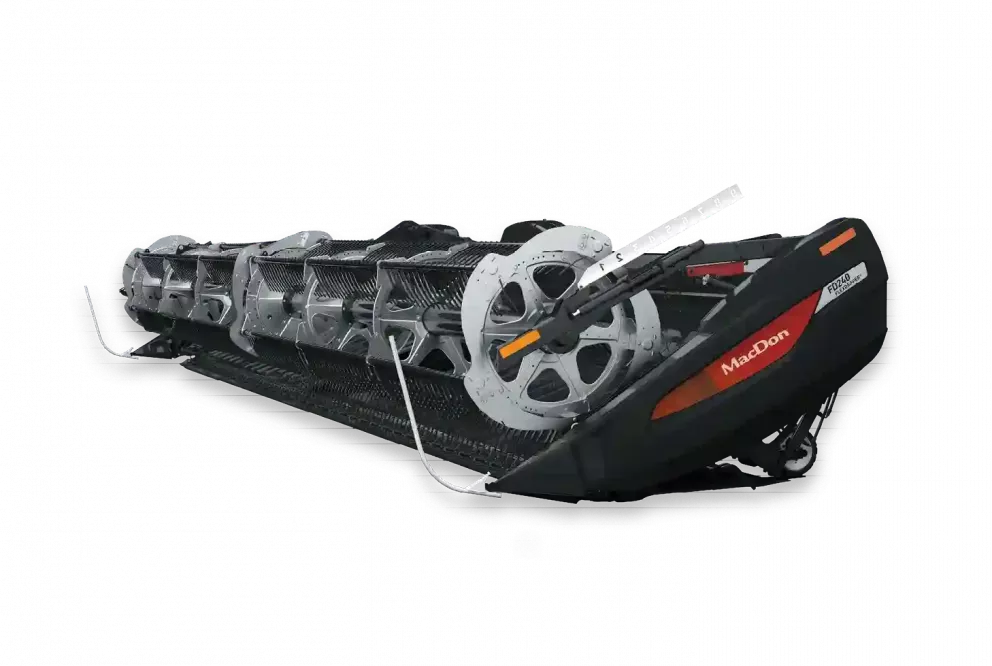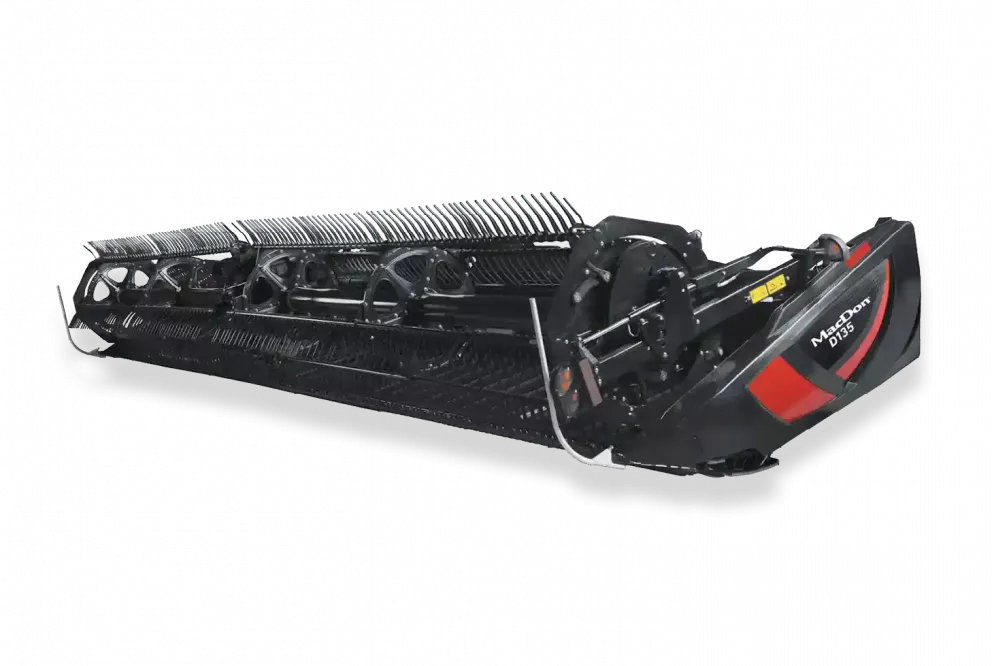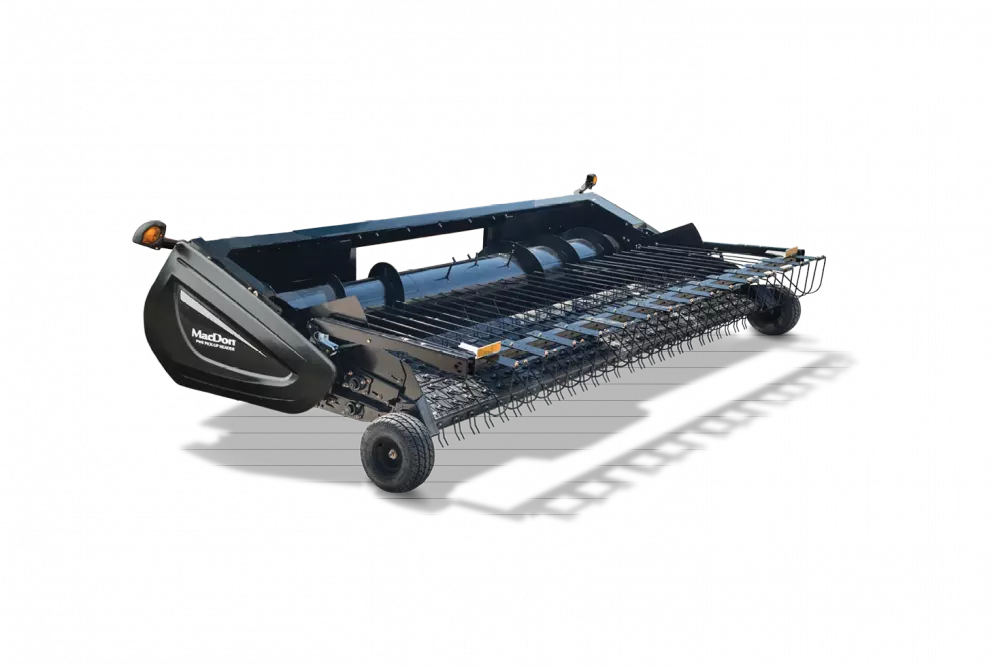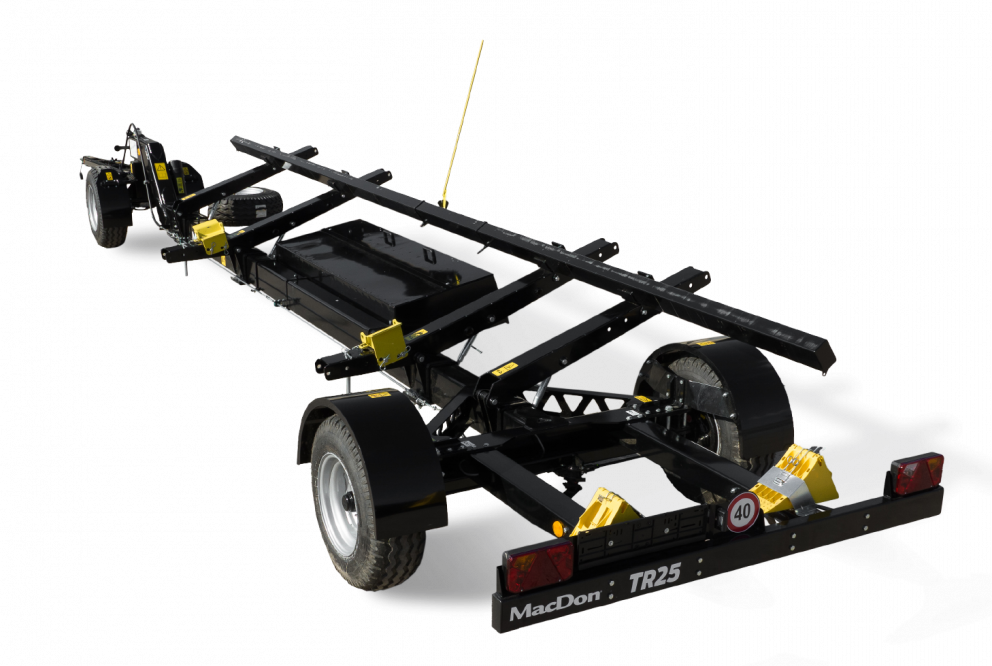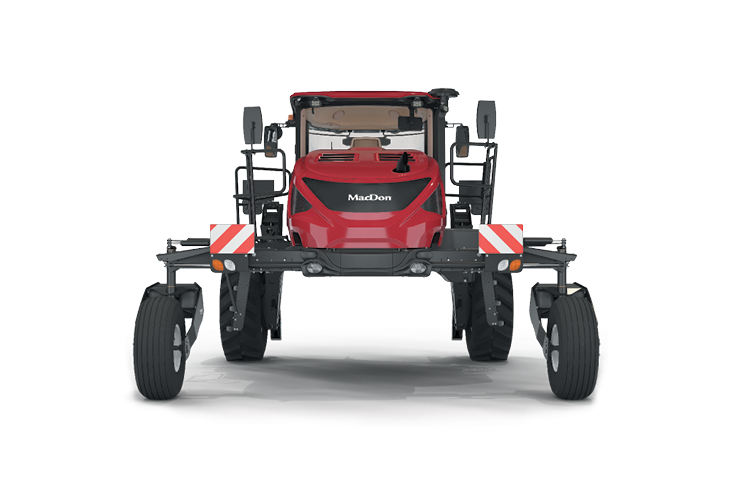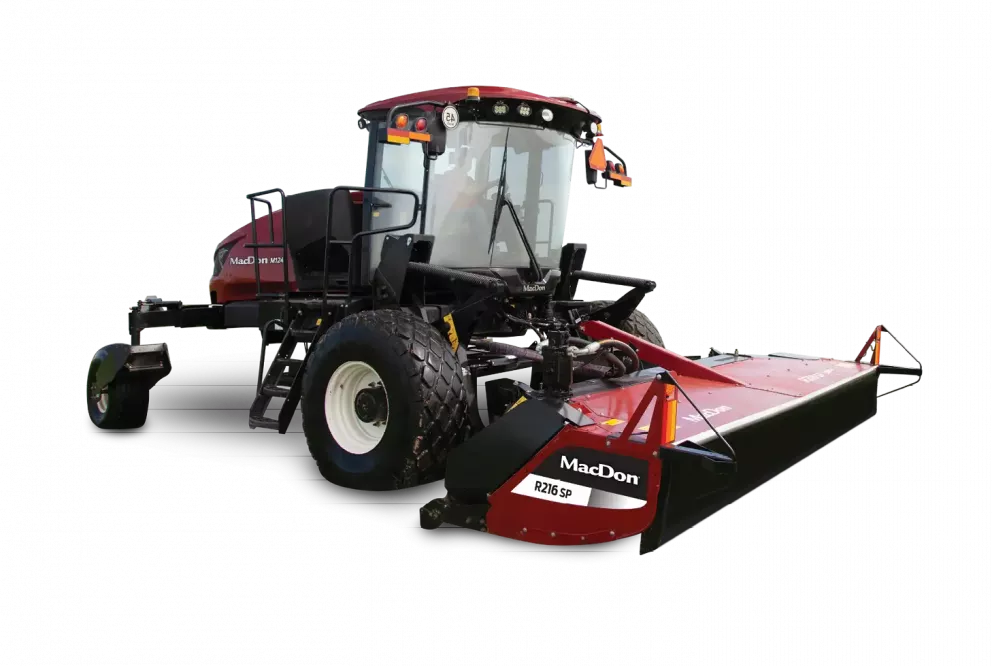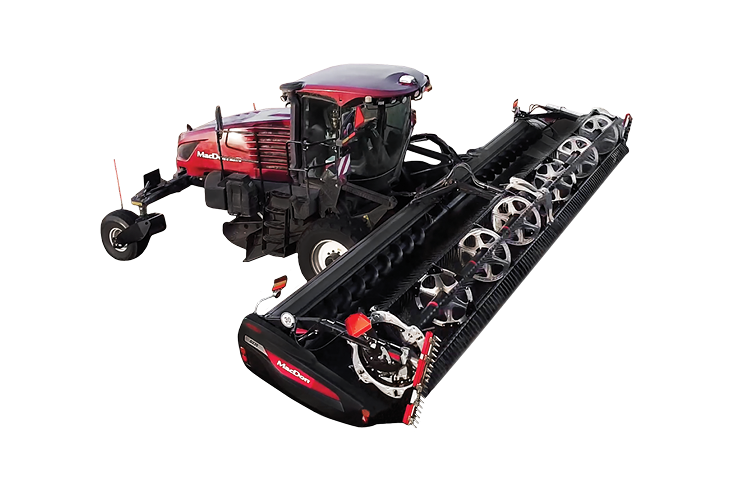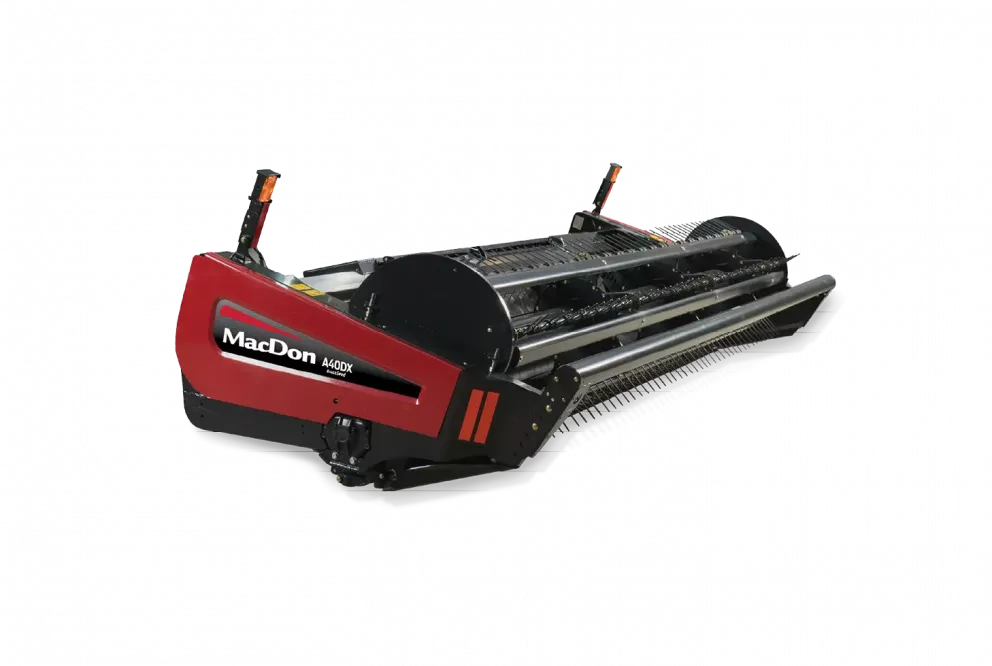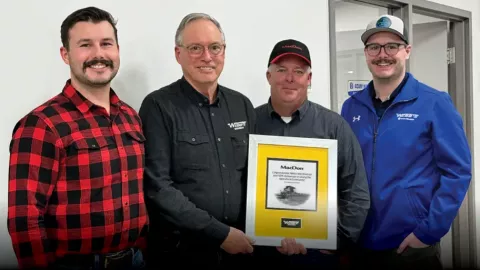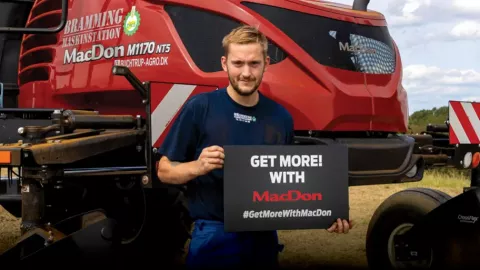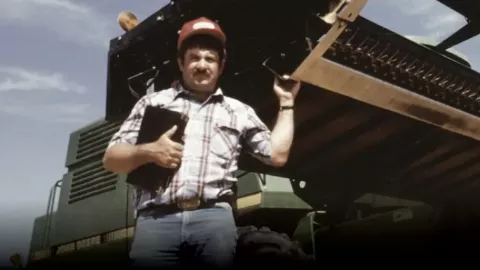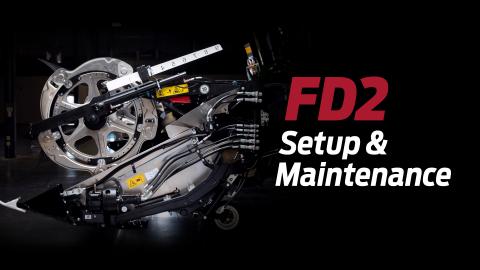Weather or Not
Despite bad harvesting conditions last year, Kim & Tony Kun felt relaxed knowing their MacDon FlexDraper® would get them through it.
GOOD MORNING,
SINCE THE END OF HARVEST I'VE BEEN MEANING TO SEND A NOTE TO THANK YOU. MY HUSBAND AND I FARM IN CENTRAL SASKATCHEWAN AND I AM THE PRIMARY OPERATOR OF THE COMBINE, RUNNING A FLEXDRAPER HEADER. WE HAD A LOT OF STRAIGHT CUTTING TO DO THIS YEAR AND I WAS A LITTLE HESITANT ABOUT HOW IT WOULD GO ON SOME OF OUR TRICKY LAND (LOTS OF HILLS AND SLOUGHS). EVEN THOUGH IT WAS A LONG HARVEST WITH CHALLENGING WEATHER CONDITIONS, I DIDN'T NEED TO WORRY; I DON'T KNOW HOW MANY TIMES I SAID TO MYSELF, "THIS HEADER IS THE CAT'S PAJAMAS." I'VE COMBINED WITH A FEW OTHER HEADERS IN THE PAST, BUT THIS ONE IS HONESTLY SOMETHING I CAN'T SEE US GOING WITHOUT AND WOULD DEFINITELY RECOMMEND IT TO OTHER FARMERS. IT REALLY HAS BEEN FANTASTIC AND I TRUST YOU WILL GET THIS MESSAGE TO ALL THE RIGHT PEOPLE. KEEP UP THE GREAT WORK!
SINCERELY,
KIM KUN
As harvests go, last year’s harvest weather had the makings of a potential disaster for Tony and Kim Kun, who manage a grain farm near Bruno, Saskatchewan, Canada.
“The weather was very challenging,” recalls Kim who does most of the combining in the husband-wife team. “I never would have thought that we would keep cutting under those conditions, but it came to a point where we really had no other choice.”
According to Tony it was all part of last year’s harvest in Central Saskatchewan, where the weather can be extremely variable and farmers can be forced to cut under less than ideal conditions.
“The weather would go from gorgeous to freak rain or snow in an instant,” says Tony. “When that happens we could be shut down for a day or two and you have to wait until it’s dry enough to start harvesting again. I call it opportune harvesting.”
Under similar conditions to last year’s harvest, the couple had once been forced to leave some of their crop in the field. Fortunately, they had a secret weapon; a MacDon FlexDraper® that they had purchased two seasons previous. Kim says that the wisdom of that decision really didn’t become apparent until this last harvest.
“It would be raining or it would be snowing, but I was really impressed that the header was able to cut through everything that it did. We really tested its abilities.”
In the end the Kuns were able to get all of their crop of wheat, soybeans, malt barley and canola off.
“There were some places in Alberta and Saskatchewan that didn’t finish until around Christmas and some guys, I think, still have crop out there. Thankfully, we had a little stretch of weather in October that we were able to get the last of our harvest in and then Tony was drying grain most of the winter.”
Kim credits their good fortune to the FlexDraper®. She was so impressed by its performance that she sent an email of thanks to MacDon following the harvest.
“There were many times during the harvest that I felt compelled to say thank you to the people that built the header because, honestly, I couldn't have imagined finishing the harvest without it.”
High school sweethearts, Kim and Tony have been married since 2004. Both grew up on farms in the Bruno area and are graduates of the University of Saskatchewan; Kim with a degree in commerce and Tony with a degree in agriculture.
“After school, work took us various places,” says Kim. “Tony worked for companies in the ag industry, and I was always doing things that were tied to ag, but in the marketing field.”
In 2009, the opportunity to take over Tony’s family farm brought the couple back to Bruno. Today, they manage the farm along with a seed business while still finding time for their three young sons; Jordan, seven, Ethan, four and Brayden, two.
IT WOULD BE RAINING OR IT WOULD BE SNOWING, BUT I WAS REALLY IMPRESSED THAT THE HEADER WAS ABLE TO CUT THROUGH EVERYTHING THAT IT DID.
The farm has been in Tony’s family since his great grandfather first broke the land back in 1904.
“The farm received the Century Family Farm Award from Information Services Corporation, so we have been here a while,” said Tony. Our farm occupies one of the early family homesteads and we can see the original family homestead from our house a quarter mile away.”
Tony says that it means a lot to both of them to be able to continue the farm in the family’s name.
“There’s absolutely a lot of pride in being able to carry on the family business. Respect for the land and the farm’s heritage is something we were both born into. A huge part of it for me is that I am able to continue on from where my forefathers had built. It’s something that not a lot of people get to experience.”
Tony says that he is reminded often of how much he and Kim are the beneficiaries of the hard work put in by the earlier generations of his family.
“I don’t know how many times I’ve been out in the field and I’m maneuvering around a huge rock pile that was handpicked. I have so much respect for what they had to go through in order for me now to be able to work the field in a nice tractor with a comfortable cab. When you think of the early homesteaders it’s amazing what they had to go through. Not many people today have it that tough.”
A quick survey of the land around Bruno gives one a glimpse into just how much of a struggle it must have been for those first homesteaders.
“To put it politely, the terrain around here is variable. Within the six or eight miles (10 or 13 km) that we farm the terrain can change drastically; it can go from flattish and open to hilly, to lots of water in a lot of sloughs and potholes. When it gets really wet, our potholes get bigger and our flatter land gets muddy. Some years you will be seeding around a slough or pothole and other years you will be seeding right through it.”
Such land will test the performance of any header, but Tony says that it proved too much for the previous header that they had used before their FlexDraper.
“When we bought our combine back in 2015 they didn’t have the header that we wanted, so the dealer loaned us a rigid draper header to use. That header was just horrible. In our canola we had to go really slow just to keep cutting, stopping often to get out to get it to feed properly.”
Kim says that she has her own bad memories of that header.
“I remember that I was straight cutting some wheat on our hilly land; it wasn’t even one of the worst hills, but I still ended up doing quite a bit of what I call landscaping, cutting into the ground. It was not easy to manage the header height at all and I ended up digging a lot of dirt and spending a lot of time pulling it off the canvasses.”
When it came time to replace that header, Tony says that he consulted some of his friends from university, who all recommended that they get a MacDon FlexDraper.
“I think every one of them except me had a MacDon FlexDraper, and they all grow lentils and peas on variable land like us. They all had really good things to say about it, but I also did quite a bit of research on the Internet and watched quite a few YouTube videos to try to distinguish it from competitive headers. What I saw with the consistent reel to cutterbar relationship kind of made sense to me for what we face with our topography around here.”
They went ahead and purchased a 40’ FlexDraper even though Tony was more than a little skeptical that they could deploy a header that wide.
“We were very reluctant to get into a 40’ header because of our hills, but my friends told me I could go wider. I said no way initially, but now that we have the 40’ I wish we had gone to 45’. I can’t see that being a problem. I just didn’t realize how well the header conforms to the terrain.”
Even with all of the good advice, both Tony and Kim admit that their first season was a learning one.
“Initially, we were trying to use the header incorrectly,” recalls Tony. “But once the dealer came out and made some minor adjustment to the flotation and showed us how to use the skid pads in the hills, it was night and day difference.”
Still, it took a while for Kim to trust that the header could cut as low as it could and not plow dirt like their previous one.
“The first year we had it I was afraid to use the header the way our dealer had shown us. I was really nervous about bending the header or putting a rock through the combine, but once we started using it correctly, the header worked much better than I ever thought it could. I was just amazed how easy it was to use and what a wonderful job it did. Our fields look like a nice lawnmower had gone over them because everything was so evenly cut.”
“We also like how the header transports using the optional transport package. Our land is broken up into two or three main areas and it can be challenging with the 40’ header going down some of our back roads that carve into a hill. The clearance isn’t wide enough between the hills. The transport package makes travel easier; Tony has it down pat and we can have the header off and behind us in no time.”
“The maintenance on the FlexDraper is something that I really like,” adds Tony. “It does not take me long to do a daily greasing around it and mostly everything else is very hands off.”
Perhaps the thing the couple appreciates most about the header is how much it has reduced the stress they feel at harvest.
“At harvest time we can go over 24 hours cutting without a stop,” says Tony. “When we are running those long hours, especially when I have to jump into the combine so Kim can run home for the kids, it’s nice not having to worry about header height or tilt angle or anything like that. We just set it once and it’s only very minimal adjustments from there. It’s amazing how the operator fatigue part of harvesting just went out the window for us.”
Kim agrees completely.
“Like I said in the email, there were many, many times last year I would be combining and I would say ‘this header is just so awesome that I have to tell someone I was that pleased.”
